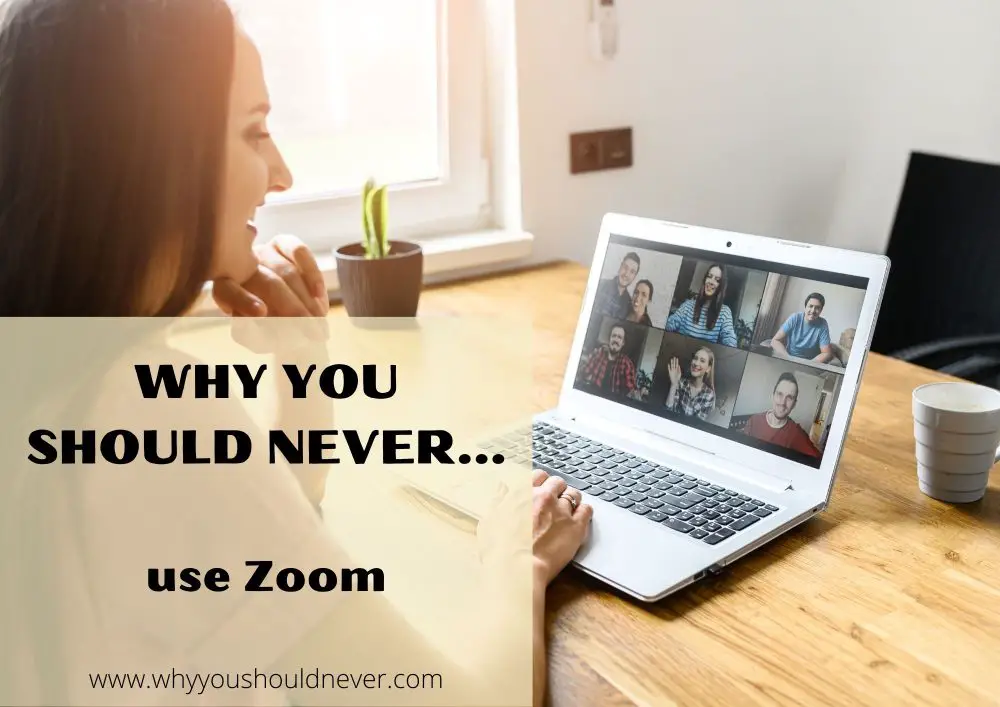![]()
Why You Should Never Use Zoom
By now, just about everyone knows what Zoom is. It’s a videoconferencing app that has become wildly popular in recent years, in no small part due to the 2020 pandemic.
Today, businesses, schools, and even families use Zoom to connect when in-person meetings are not possible. In that way, Zoom has established itself as a valuable tool.
While Zoom can be useful and convenient, as with any type of technology, there’s a dark side to it that users need to be aware of before they hit that “Join Meeting” button. In this article, we’ll discuss the many reasons why using Zoom over other videoconferencing platforms is a bad idea.
8 reasons why you shouldn’t use Zoom
1. Privacy violations
In March 2020, it was discovered that Zoom was sharing users’ data with Facebook and Google without their knowledge or consent.
Additionally, one of Zoom’s features was found to secretly display LinkedIn information about meeting participants to other attendees without their knowledge or consent.
And if that wasn’t bad enough, the company has also been accused of using “attention tracking” to spy on users and track if they’re paying attention during meetings. Needless to say, these are not the actions of a company that respects its users’ privacy.
2. Security breaches galore
Zoom has been plagued by security breaches in recent years. In April 2020, it was revealed that Zoom had a major security flaw that allowed hackers to steal 500,000 passwords and sell them on the dark web.
And in August 2022, another major security flaw was discovered that would allow hackers to potentially take over Mac users’ computers. This prompted the company to issue an update for all Mac users.
Additionally, Zoom has been known to allow “zoombombing,” where uninvited guests can join meetings and disrupt them. This has led to some sensitive and private meetings being infiltrated by trolls and others with malicious intent.
In August 2021, Zoom had to pay $85 million to settle a class-action lawsuit over its alleged privacy and security violations.
3. Choppy video and audio
Despite its popularity, Zoom’s audio and video quality are actually quite poor in comparison to other videoconferencing platforms.
Many users have complained of choppy video, audio that cuts in and out, and overall poor call quality. This can make meetings frustrating and difficult to follow.
4. Limited features for free users
If you’re not paying for a Zoom subscription, you’re severely limited in what you can do with the app. Free users are limited to 40-minute calls before they’re kicked off the call, and they can only host up to 100 participants.
If you want to do more than that, you have to sign up for one of Zoom’s paid plans.
How much does Zoom cost?
Zoom Pro costs $149.90 annually. You get unlimited time and 5GB of cloud storage. For business users, Zoom Business costs $199.90 annually and has all the features of Pro but you can have up to 300 participants.
5. It’s not that easy to use
While Zoom may seem easy to use at first, there are actually a lot of features and settings that can be confusing for users, especially those who are not tech-savvy.
There have been many reports of people struggling to figure out how to use Zoom properly, and even more reports of people not using the app correctly and accidentally showing their private information to others.
One common mistake is not knowing how to properly screen share. If you don’t know what you’re doing, you could accidentally share your entire screen, which would give other participants access to all of your open tabs and any sensitive information that is displayed on your screen.
Another example is not knowing how to properly use the “mute” and “stop video” features. If you accidentally leave your microphone on, everyone in the meeting will be able to hear any background noise, and if you accidentally leave your video on, everyone will be able to see you even if you’re not paying attention to the meeting.
6. Huge battery drain
If you’re using Zoom on your mobile device, be prepared for your battery to drain quickly. The app is known to be a huge battery hog, and it can cause your phone or tablet to heat up quite a bit.
This is especially true if you’re on a video call for an extended period. Now, granted, this is true of any videoconferencing app, but it’s worth mentioning nonetheless.
7. The company is based in China
Although Zoom is technically a US company, the vast majority of its development team is based in China.
This raises some concerns, especially given the recent tensions between the US and China. Some people worry that the Chinese government could force Zoom to hand over user data or even allow them to spy on users.
Of course, there’s no evidence that this has actually happened, but it’s something to keep in mind if you’re worried about privacy and security.
8. It’s not open source
Unlike many other popular applications, Zoom is not open source. This means that the code is not publicly available for anyone to inspect and there is no way to verify that the app does not contain any malicious code.
This also means that there is no community of independent developers who can audit the code and find security vulnerabilities.
Alternatives to Zoom
So now that you know some of the reasons why you should avoid using Zoom, what are some alternative videoconferencing apps that you can use instead?
Here are a few options:
- Google Hangouts
- Skype
- FaceTime
- GoToMeeting
- WebEx
- Telegram
Each of these apps has its own advantages and disadvantages, so be sure to do your research before choosing one.
